
1
TWA Stewardess
This wonderful TWA issue reminds us of the pride and optimism of the formative years of this great airline.
| 
2
TWA (Western Air Express) Fokker F-32
The unique Fokker 32, operated by Western Air Express, had no future with TWA, but had the distinction of being the 1st 4 engined aircraft. This image is from a TWA fleet history published in 1977. The only postcard I've seen showing the airliner is an early Kansas City airport issue.
| 
3
TWA (TAT) Ford Trimotor #2 KCF
Transcontinental Air Transport used the Ford Tri Motor, along with a couple of trains, to traverse the continent. This great in flight view of the restored Transcontinental Tri Motor was provided by Kuo-Ching Fu.
| 
4
TWA Ford Trimotor #1
This image of the Tri-Motor in TWA colors also came from TWA's 1977 fleet brochure.
|

5
TWA DC-1 #4
TWA received the DC-1 aircraft in December 1933, and successfully placed it in service. The DC-1 did traverse the country without the assistance of trains, in Feb 1934 in 13 hours and 5 minutes.
| 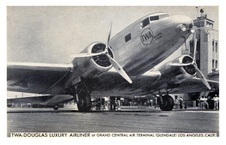
6
TWA DC-1 #5
The only DC-1 ever built operated with TWA until 1938, ultimately ending its service with Iberia in a 1940 crash.
| 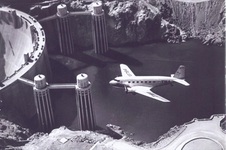
7
TWA DC-2 #4 KCF
The more powerful DC-2 arrived in May of 1934, and by the end of 1935, the first TWA Air Hostess took over the cabin. Air Travel was no longer a novelty.
Shown is a TWA DC-2 flying over the not yet impounded Lake Meade and Hoover Dam. Card by courtesy of Kuo-Ching Fu.
| 
8
TWA DC-2 #3
Despite the DC-2's remarkable achievements, it was quickly rendered obsolete by the Douglas Sleeper Transport, in 1936. Shown is the only color DC-2 image I've found, a collector card from Player's Cigarettes.
|

9
TWA DC-3 #10
The "Douglas Sleeper Transport" entered service with TWA in April, 1937, accommodating transcontinental passengers with 8 berths and 7 seats for night operation, and 15 seats in daylight travel. The card is a rather hard to find pre-war TWA issue.
| 
10
TWA DC-3 #6
This is a later image of Skysleeper NC 17312, featuring the twin tail stripes adopted by TWA after its service in WW 2.
It later served 15 years with North Central.
| 
11
TWA DC-3 #5
Perhaps the earliest TWA color issue is this "Skysleeper" over New York City.
| 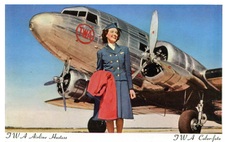
12
TWA DC-3 #4
A most important part of the image of TWA was the glamorous hostess, as featured on this excellent DC-3 card.
|

13
TWA Stratoliner #3
The year 1940 brought the Stratoliner to TWA, (as well as Howard Hughes), one of which was used personally by Hughes. The Stratoliner made the cross country trip in 13 hours, 40 minutes.
| 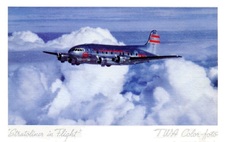
14
TWA Stratoliner #4
The Stratoliners were also equipped with 16 berths and 9 seats. However, the Stratoliners were "drafted" for military service in 1942, returning after the war. TWA's fleet was sold to Aigle Azur of France in 1951, as Constellations effectively obsoleted them.
| 
15
TWA DC-4 #4
In February 1946 TWA's Trans Atlantic scheduled flights began with DC-4s, from New York to Paris. This excellent art card of the DC-4 over Geneva is one of 3 TWA issues featuring the aircraft over international destinations
| 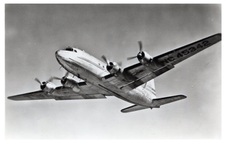
16
TWA DC-4 #1
By June of 1946 DC-4s were operating as far East as Cairo, with each aircraft bearing names such as Taj Mahal, Colosseum, Sphinx and Acropolis. The card is a vintage DRC issue
|
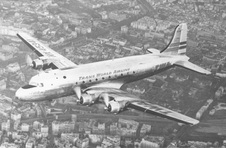
17
TWA DC-4 #6 KCF
By June of 1947, TWA DC-4s reached to Bombay, India, but by 1949 only 2 Trans Atlantic flights per week remained. In the early to mid 50s the DC-4s were operating "Sky Tourist" discount flights in the US. This rare card from the Int'l Airline Museum shows the first TWA DC-4, christened The Taj Mahal after modification for civilian operation. Card by courtesy of Kuo-Ching Fu.
| 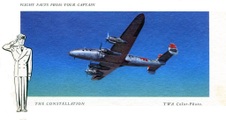
18
TWA Constellation #2
The L049 Constellation, commissioned by Howard Hughes and TWA certainly became the symbol of the airline. The first Constellation delivered to TWA was on Nov. 15, 1945. On Feb. 5, 1946 it joined the DC-4 on Trans Atlantic services.
| 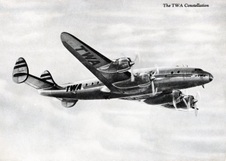
19
TWA Constellation #12
Most early Constellations went into premium extra fare domestic flights. This card is a rare Jumbo Post Card issue from approximately 1948
| 
20
TWA Constellation #8
The Constellations assumed all international flights by 1950, and 4 very nice artist cards were issued each flying over European destinations.
|
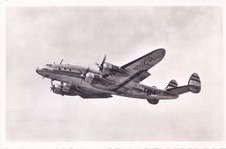
21
TWA Constellation #29 KCF
The L-749 Constellations had joined the fleet by 1948, as shown on this outstanding Flug Foto Schait issue, kindly provided by Kuo-Ching Fu. Originally titled the Star of Pennsylvania, N 91202 became the Star of Madrid in 1950. It operated until the end of 1966.
| 
22
TWA Constellation #30 KCF
A very rare Japanese colorized issue of a TWA Constellation in flight, also provided by courtesy of Kuo-Ching Fu.
| 
23
TWA Constellation #16
Later Constellations appeared with the white fuselages, as shown on this Los Angeles Airport card
| 
24
TWA Constellation #17
The Constellations flew well into the 1960s, re-equipped with radomes, in the TWA "jet age" livery. The last Constellation operation was in April 1967.
|
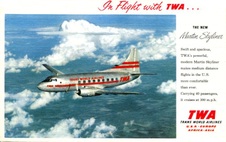
25
TWA Martin 202 #2
TWA received their 12 Martin 202s in 1950, effectively obsoleting the DC-3s. They operated for 8 years, and were then sold, mostly to Allegheny as Martin "Executives".
This common TWA issue was circulated long after the arrival of the 404s, and the description would seem to describe the 404.
| 
26
TWA Martin 202 #3KCF
TWA's experience with the 202 was far more favorable than that of Northwest, losing only one to a mid air collision. The sleek 202s after receiving white fuselage paint were virtually indistinguishable from the 404s, and TWA did not differentiate them on their schedules. This stunning card of the 202 was provided by courtesy of Kuo-Ching Fu
| 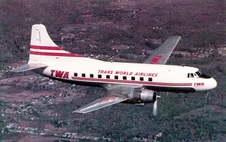
27
TWA Martin 404 #2
TWA ordered 40 Martin 404s to add to the dozen 202s. Delivery started in 1951, but no new cards were issued. This excellent IAWP issue gives a very nice view of the 404 in flight.
| 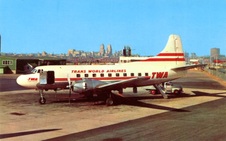
28
TWA Martin 404 #1
For a decade TWA Martion 404s handled the short to medium range flights for TWA, and then populated the fleets of Piedmont and Pacific for more than an additional decade. This one, shown on a Newark Airport issue, operated only 7 years, and later operated for Danny Davis and the Nashville Brass.
|

29
TWA L-1049 Constellation #3
The Super Constellation was added in 1952, inaugurating non stop service from LA to New York in 8 hrs. This excellent TWA issue seems less common than others, perhaps prematurely obsoleted by the Super G.
| 
30
TWA L-1049 Constellation #4
By the end of 1953 Super Constellations were serving only New York Chicago Kansas City and Los Angeles, with eastbound (only) non-stops from LA to New York.
The card is a vintage Enell issue.
| 
31
TWA L-1049 Constellation #5 KCF
The Super Constellation was the ultimate airliner in 1953 and 1954, flying mostly from New York to Chicago and the far West. This great view of the 1049 over New York City is a Frontier Productions issue by courtesy of Kuo-Ching Fu
| 
32
TWA L-1049 Constellation #6 KCF
A beautiful view of the Super Constellation in western skies. Sadly N6902C, the first Super Constellation put in service was destroyed in the Mid Air Collision over Grand Canyon in June of 1956. ( This aircraft is N6909C)
Card by courtesy of Kuo-Ching Fu
|

33
TWA L-1049G Constellation #2
The year 1955 brought the fabulous Super G to TWA, the emblem of the airline, and known to children of the time from the "What I want to be" segment of the Mickey Mouse Club. The Super G took over long haul domestic flights, but did not immediately take over Trans Atlantic flights.
| 
34
TWA L-1049G Constellation #10 KCF
This vintage Enell card shows the Super G over New York City in 1955.
By Fall of 1956 the Super G's were flying the Atlantic but most operations were still by 749 Constellations.
This card by courtesy of Kuo-Ching Fu
| 
35
TWA L-1049G Constellation #9KCF
As the era of jets approached the Super G found its way to smaller destinations on TWA's system, such as Louisville, and I was thrilled by the sound of those Turbo Compound engines.
The card is one of the Ciel de France series by Editions PI, by courtesy of Kuo-Ching Fu.
| 
36
TWA L-1649 Constellation #1
The long range 1649 Constellation, designated as the Jetstream, entered service in 1957, and inaugurated the polar route from Los Angeles to London on September 28.
|

37
TWA L-1649 Constellation #2
This vintage Plastichrome card provides a nice view of the TWA 1649 Constellation, a splendid new airliner that became obsolete within 2 years.
The Jetstream did take over all International flights, at last obsoleting the 749s.
| 
38
TWA L-1649 Constellation #4GS
One more very nice view of the Jetstream on a vintage Jaeger issue by courtesy of Greg Smith.
| 
39
TWA 707-120 #1
In March of 1959 TWA introduced the 707-131, operating non stop from San Francisco to New York.This was the first TWA issue, in the classic TWA format.
| 
40
TWA 707-120 #3
The 707 quickly took over international routes, and by 1962 Jetstreams were reduced to Trans Atlantic freighters, while still serving domestic destinations.
The Plastichrome card shown obviously uses the same image as the AI but gives us a better view.
The full size view was released on at least 3 subsequent TWA issues.
|

41
TWA 707-120 #9
TWA ultimately flew 127 707s. This splendid view of N731TW is on a vintage Editions PI "Ciel de France" issue.
| 
42
TWA 707-320 #1 KCF
TWA took delivery of a number of 331s before replacing with Fan Jets. Card is part of a German TWA set from approximately 1966, kindly provided by Kuo-Ching Fu.
| 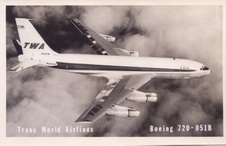
43
TWA 720B #3 KCF
The first fan jets operated by TWA were 4 720Bs ordered by Northwest but not immediately accepted. TWA took delivery in 1961, and operated them for a little over a year before returning to ultimately serve Northwest.
| 
44
TWA 720B #1
The 720Bs seemed strange given the fact that TWA Convair 880s were being leased to Northeast at the time. TWA was anxious to operate the Turbofans, and subsequent aircraft deliveries were B models. The card is a nice Aviation World issue. Aviation World comprehensively covered TWA aircraft.
|

45
TWA Convair 880 #2
With Howard Hughes at the helm, TWA ordered 35 Convair 880s. Given the significance of the order, and a great deal of promotion, it was surprising that no postcards were issued. This is from a vintage German set of TWA cards, that some say were TWA issued.
| 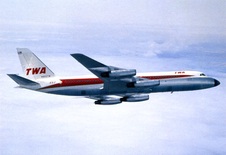
46
TWA Convair 880 #4
N815TW was leased to Northeast in December 1960, operating until August 1963. It then joined TWA, serving until 1974. It was originally equipped with 50 first class and 35 coach seats, plus a forward "Ambassador Sky Room".
Card is an outstanding WGA issue
| 
47
TWA 707-320B #3
N775TW, shown on this TWA issue was the first 331B delivered to the Airline on Dec. 3, 1962. There were at least 3 printings of the card with completely different backs.
| 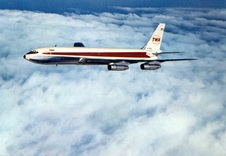
48
TWA 707-320B #2
The 707-331Bs served TWA for nearly 20 years, and were familiar sights at airports in Europe as well as the US. A number of the contemporary European publishers issued very nice cards, including this nice Mexichrome card.
|

49
TWA 707-320C #2 KCF
This vintage German issue is one of the 5 card TWA set, kindly provided by Kuo-Ching Fu. Shown is one of only 2 331Cs acquired by TWA on June 12, 1964. It operated until 1985 and went to the US Air Force.
| 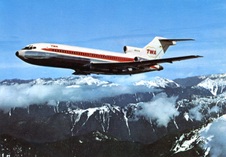
50
TWA 727-100 #4
TWA inaugurated 727-031 services in June of 1964, opening jet service to a number of new destinations. It seems surprising, given TWA's postcard history that no airline issues accompanied the introduction.
The excellent view above is a vintage Photoglob issue.
| 
51
TWA 727-100 #9 KCF
The new 727 was represented on the black and white German set, as well as other European publishers. N853 TW was delivered on May 21, 1964, and operated until May of 1991 when sold to Aeroexo of Mexico.
| 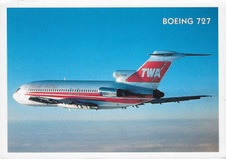
52
TWA 727-100 #10 bm
The 727s were found to be ideal for the distribution of passengers on the European side, connecting to 747s at major destinations such as Paris or Rome.
Card is an Editions Combier issue. Thanks to Bertrand for sharing!
|

53
TWA 727-100 #6
The only TWA issues featuring the 727 were later oversized destination cards, such as the Florida card above.
| 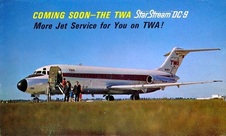
54
TWA DC-9-10 #2
In February 1966 the first TWA DC-9-14 arrived. The new DC-9s were capable of serving the remaining Constellation segments, and by 1967 TWA became America's first all jet airline. This Douglas prepared card is rather hard to find.
| 
55
TWA DC-9-10 #3 KCF
A final card in the German issued set is this splendid in flight view, provided by Kuo-Ching Fu. The aircraft shown is N1051T, the first DC-9 delivered to TWA, which was sold to Texas International in 1977, and became a Continental aircraft for another decade before going to Aero California.
| 
56
TWA DC-9-10 #4 KCF
The original DC-9s operated through 1980, but were supplemented with additional aircraft with the integration of Ozark into TWA in 1986. This card is a rare Spirotone issue by courtesy of Kuo-Ching Fu
|
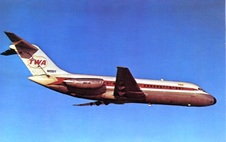
57
TWA DC-9-10 #1
The only color in flight card I've found is this nice Aviation World issue.
| 
58
TWA 727-200 #1
The first 727-231 was added to the fleet in 1968, and operated 26 years before retirement. The aircraft dominated domestic routes and replaced the 031s in Europe.
The card is an Aviation World issue.
| 
59
TWA 727-200 #2
The advanced model as shown on this and the previous Aviation World card, entered service in 1979. Shown is N54341, the first advanced version delivered which served TWA for 20 years.
| 
60
TWA 747-100 #14
On February 25, 1970, TWA launched the first US 747 service, non stop from Los Angeles to New York. The card is a splendid TWA issue of aircraft and crew.
|

61
TWA 747-100 #6
There are a lot of postcards of N93103, this beautiful 747-131 delivered in December 1969. It pioneered Trans Continental 747 service, and cruised the Atlantic, but oddly only for 7 years before sale to the Iranian Air Force.
| 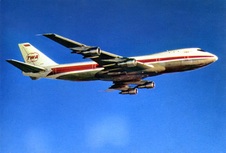
62
TWA 747-100 #13
My favorite of the TWA 747s in original colors is this splendid Mexichrome issue. After 30 years of service most of the 131s were scrapped, but some continued in service for Tower Air or Evergreen International.
| 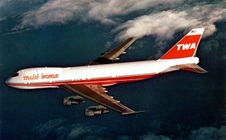
63
TWA 747-100 #12
This later TWA issue, from the mid 1970s was produced in both oversized and Continental size. This scheme was flown on TWA airliners until the very last years.
| 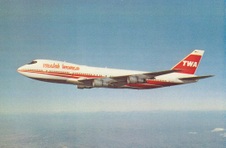
64
TWA 747-100 #24 KCF
This outstanding oversized TWA 747 was shared by Kuo-Ching Fu. It seems that most later TWA issues were oversized.
|

65
TWA 747-100 #11
In my view the most beautiful 747 that ever took to the air was this one, N 93108, in TWA's final colors. Most Trans Atlantic services were being operated by 767s by the time she was retired after 28 years in service.
| 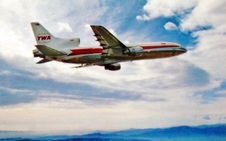
66
TWA Tristar #1
TWA was a launch customer for the Tristar, delivered in 1972. As a demonstration of Tristar technology the inaugural flight from St. Louis to Los Angeles is conducted entirely by autopilot.
| 
67
TWA Tristar #8
Much like the Constellation, the large fleet of Tristars became a symbol of TWA , and operated to many medium sized as well as larger cities in TWA's network.
Ultimately TWA would operate 37 Tristars.
| 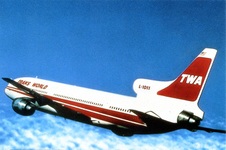
68
TWA Tristar #5
Early Trstars were equipped with a coach lounge/ bar with seating for 10, and in 1st class 2 sets of seats in the center row could be rotated to create a 4 place table for dining.
. In March of 1973, the coach lounges were removed.
|
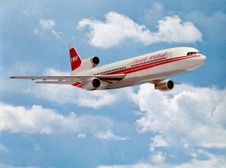
69
TWA Tristar #6
By 1975 the coach lounges were removed and additional seats added. As additional Tristars were received new destinations were added, and in 1978, six Tristars were converted to L1011-100 models, equipped for Trans Atlantic service. In later years additional conversions were made
| 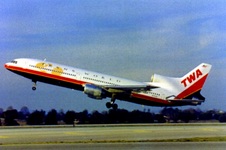
70
TWA Tristar #7
In November 1995 TWA began converting to its new and sadly final, livery. The chic new appearance seemed to be accompanied by new optimism and a feeling that this new identity might equate to the enormously successful rebranding of Continentall.
The card is from an unidentified publisher.
| 
71
TWA Concorde #2 KCF
In 1965, the race was on for a supersonic transport, and the Concorde appeared to be the first option. No one wanted to be the airline that didn't have one so TWA placed an order (non binding option, really), for 6 aircraft. As Arab fuel embargoes and other events took place in the early 70's the allure of supersonic transport waned, and in January 1973 TWA cancelled.
The card is a remarkable and rare card from a historic Concorde set, kindly provided by Kuo-Ching Fu.
| 
72
TWA Boeing 2707
With a defensive Concorde order in place for 6, TWA became the first order for the Boeing 2707, with an order for 12, beating Pan Am for a change. Alas, we know what happened to the SSTs.
The card is a Michel and Co. Issue.
|
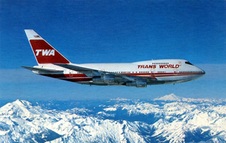
73
TWA 747 SP #1
In March of 1980, TWA received the first of three 747 SPs, which were intended to serve anticipated Asian Long Haul authority. Upon Arrival, they operated US European segments upon which lower passenger capacity was practical.
Card is part of Aviation World's thorough coverage of TWA.
| 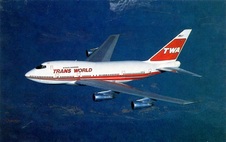
74
TWA 747 SP #2
TWA's route authority did not materialize, and the SPs were sold to American in 1986. This image is also Aviation World
| 
75
TWA 767-200 #2
The first TWA issue of their 767-200 was this nice oversized card. N601 TW was the first of 10 767-200s delivered from November 1982- Nov. 1983. The 767s were almost exclusively used for longer stages.
| 
76
TWA 767-200 #4
In May of 1985, TWA was awarded the first ETOPS rating for 767s non stop from St. Louis to Frankfurt. The efficient 767s became the dominant Trans Atlantic Aircraft for TWA in later years.
|

77
TWA MD-80 #6
In 1983, TWA took delivery of the first of 104 MD-80 aircraft, which finally obsoleted the 727 fleet. This image is from a set of photos TWA issued in lieu of postcards.
| 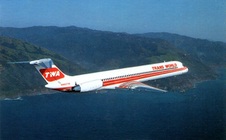
78
TWA MD-80 #2
N902TW was the 2nd to be delivered to TWA, operating through the merger, and was retired in 2003 after 20 years of service.
Card is an Aviation World issue.
| 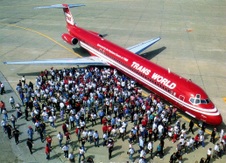
79
TWA MD-80 #5
The only TWA issue of the MD-80 was the Wings of Pride aircraft, now restored and in the TWA museum. The airliner came from Guiness Peat after operation with Spantax and BWIA and reflected new employee participation in the ownership of TWA.
| 
80
TWA MD-80 #4
The MD-80s looked great in the final TWA livery. Shown is a later MD-83 model delivered in 1995.
The card is an IAWP issue #896.
|

81
TWA DC-9-50 #1
In 1993 and 1994, TWA leased a dozen DC-9-50s from McDonnel Douglas, while awaiting delivery of more new MD-80s. They operated a little over 5 years. TWA also operated a fleet of DC-9-30s and 40s long after the Ozark acquisition
The card is an IAWP Historical issue #830.
| 
82
TWA 757-200 #1
TWA continued to upgrade the fleet by adding 27 757-200s beginning in 1996. This one, a view of N713TW landing at Las Vegas is a Buchair issue
| 
83
TWA 767-300
TWA began receiving 767-300s in 1998, receiving eight by 2000. Sadly no cards were issued of the 300 model. Shown is the only in flight photo I have found. N639TW was the last 767-300 received by TWA. The 300s served Trans Atlantic services until the merger.
| 
84
TWA 717 #1 KCF
Finally, TWA ordered 50 717 jets to serve domestic routes. This great Boeing issue was provided by Kuo-Ching Fu. My last flight on TWA from St. Louis to Louisville was on the new 717.
|
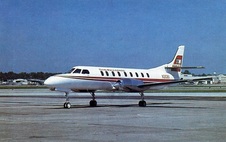
85
TW Express Metro
In 1986 TWA, like other majors added commuter flights centered on St. Louis. This Metro, originally a Horizon Air aircraft, operated for Resort Air at the St. Louis hub.
The card is an Aviation World issue.
| 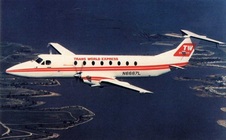
86
TW Express Beech 1900
This Beechcraft 1900C was the first aircraft off the line in 1983. By 1990, it was serving TWA at New York, operated by Metro Air Northeast. The card, a Plane Views issue, indicates that every seat is both a window and aisle seat. It doesn't get any better than that!
| 
87
TW Express J-31 Jetstream
An outstanding card of a Trans States operated J-31 Jetstream flying over TWA's main hub , St.Louis in the early 1990s.
| 
88
TW Express Saab 340
An excellent card of a TW Express Saab 340, operating for Metro Air Northeast around 1990.
This wonderful airliner brought cabin service and , better yet, restrooms to commuter flight.
Card is a Plane Views issue.
|
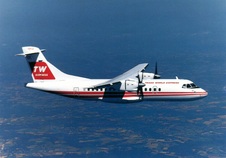
89
TW Express ATR-42 #2
The ATR-42s arrived at Trans World Express in Philadelphia in 1987, and were added to Trans State's fleet a year later. The aircraft was a substantial upgrade in comfort on TWA's connecting flights.
This card is an Avimage issue.
| 
90
TW Express ATR-72
The ATR-72 joined the Trans States fleet in March of 1991, barely resembling the commuter fleets of a decade earlier. This card is a Plane Views issue.
| 
91
TW Express ERJ-145
Once again, in my view, the most beautiful 145s to operate were the Trans States and Chatauqua ERJs operated in TWA's final livery.
Card is another Plane Views issue.
| 
92
TW Express J-41 Jetstream
The beautiful J-41 Jetstream operated for Trans States from 1996 to the sad final days of TWA. My last TWA flight included the J41 from Columbia Mo. To St. Louis.
|
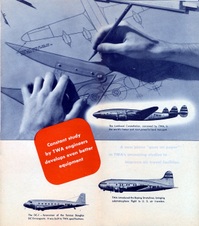
93
T W A The Air Age
| 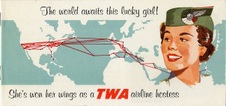
94
T W A Stewardess Booklet
| 
95
T W A Super G Brochure
| 
96
T W A Souvenir Flight Pack 1945
|
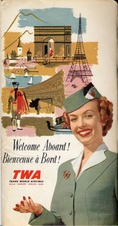
97
T W A Souvenir Flight Pack #2
| 
98
T W A Schedule June 1, 1945
| 
99
T W A Schedule Apr. 7, 1996
| 
100
TWA Stewardess #2 bm
|